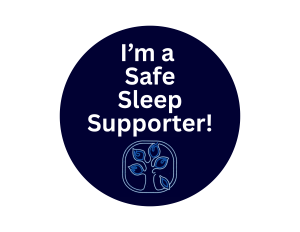
Weighted sleep products have become a popular trend in the baby market, promising longer, more peaceful sleep for infants. However, the science and safety recommendations tell a different story. It’s essential for parents and caregivers to understand why weighted sleep sacks are not safe for babies and what the leading medical and safety organizations advise.
The rise of weighted sleep products
The baby sleep industry knows that parents are motivated to get more sleep. Weighted sleep products are designed to apply gentle pressure and are often marketed with terms like "calming" or "anti-startle." This concept is similar to the use of weighted blankets for adults, but applying weight to infants is a different—and very dangerous—matter. Weighted sleep products typically use small beads or pellets sewn into specific areas of a sleep sack or swaddle, creating localized weight.
What’s wrong with weighted sleep sacks?
Despite marketing claims, leading medical and safety organizations, including the American Academy of Pediatrics, the U.S. Consumer Product Safety Commission, and SIDS of Illinois strongly advise against the use of weighted sleep products for infants. Here's why:
Weighted sleep sacks make it harder to breathe
A baby's respiratory system is still developing, and their rib cages are much more pliable than an adult's. Applying weight to a baby's chest or abdomen, even what seems like a small amount, can potentially compress their lungs and diaphragm. This makes it harder for them to breathe effectively, especially during sleep. This concern is amplified if a baby moves into a position where the weight is unevenly distributed or shifts, causing even greater pressure.
Weighted sleep sacks make it harder for babies to wake up
One of the key protective mechanisms against SIDS is a baby's ability to wake themselves up from sleep if they are in distress or experiencing breathing obstruction. Weighted sleep products may inhibit this crucial arousal response. If a baby's breathing is compromised, or if they accidentally roll into an unsafe position, a weighted product could make it harder for them to wake up or reposition themselves.
Weighted sleep products can cause entrapment and suffocation
If the weighted material shifts or bunches, it could potentially create pockets or pressure points that pose a risk of entrapment or suffocation. The movement of a baby during sleep, combined with shifted weights, could lead to unexpected hazards.
Weighted sleep products lack safety standards and research
Currently, there are no specific safety standards for weighted infant sleep products. Furthermore, there is no scientific evidence that these products are safe or effective for babies. The risks far outweigh any purported benefits, which themselves lack empirical support. The CPSC has been clear on its stance, advising against their use due to safety concerns.
Safe alternatives for better baby sleep
Instead of weighted sleep products, focus on pediatrician-approved strategies and safe alternatives that support healthy, safe sleep for your baby:
Wearable blankets (sleep sacks)
These are the gold standard for keeping babies warm without the risk of loose blankets. Choose a non-weighted sleep sack appropriate for your room temperature (check the TOG rating) and the correct size for your baby. Wearable blankets allow for free movement of limbs and won't cover your baby's face.
Swaddles (for newborns, until rolling)
For newborns, use a swaddle that allows for hip healthy positioning can help soothe the startle reflex and promote sleep. It's crucial to stop swaddling as soon as your baby shows any signs of attempting to roll over, as swaddling a baby who can roll could restrict their ability to get back onto their back.
A firm, flat sleep surface
Always place your baby on their back in a crib, bassinet, or portable play yard with a firm, flat mattress and a fitted sheet. This bare sleep environment is the safest, as it removes the risk of extra items that can suffocate or trap your baby.
Pacifier
Studies show that offering a pacifier at naptime and bedtime can help reduce the risk of SIDS. If your baby takes one, don't force it back in if it falls out, and don't attach it to any strings or clips. If you're breastfeeding, it's recommended to wait until breastfeeding is well established (usually around 3-4 weeks) before introducing a pacifier.
Room-sharing (not bed-sharing)
The AAP recommends room-sharing (baby sleeps in their own safe sleep space in your room) for at least the first six months, and ideally a year. This allows for closeness for feeding and monitoring without the significant risks associated with bed-sharing.
Consistent bedtime routine
Establishing a calming and consistent bedtime routine can signal to your baby that it's time for sleep, helping them settle.
Choose safe sleep, not weighted sleepers
Marketing for weighted sleep sacks may sound appealing, but the overwhelming consensus from medical and safety experts is clear. Weighted sleep sacks are not safe for infants due to risks of death. Prioritize the ABCS of safe sleep – Alone, Back, Crib, Smoke-free – and choose pediatrician-approved alternatives that have been proven to protect your baby. When in doubt about any baby product, always consult your pediatrician, the CPSC or CDC website, or SIDS of Illinois. Your baby's safety is worth making careful decisions.
About SIDS of Illinois
Sudden Infant Death Services of Illinois, Inc., is a not for profit, 501(c)(3) organization dedicated to the prevention of sudden, unexpected infant death by providing educational programs to families, healthcare professionals, law enforcement, childcare providers, and the general public as well as bereavement services to families and any others who have experienced the tragedy of sudden, unexpected infant death. Donate here to become a Safe Sleep Supporter!
